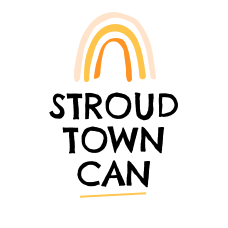Creating coppice woods in Uplands
Uplands has two new areas of mixed coppiced woods, that over the next few years will grow up to be a local amenity, a wildlife haven, and a help in fighting climate change.
How did that happen?
Stroud Town Council, one of the CAN partners, has planted two small areas of coppice woods in Uplands. They’re each about 600 square metres in size (like the space in front of the Sub Rooms), and planted with a wide variety of native trees and shrubs, like field maple, hazel, aspen, wild cherry, small- leaved lime, pedunculate oak, dogwood, hawthorn, spindle, holly, common privet, crab apple, wild service tree, yew, wayfaring tree, and guelder rose.
Why have they done it?
The right selections of trees trees planted together in the right places bring all sorts of benefits to a neighbourhood and the people living in it.
They add to people’s enjoyment of living in a place, and to their sense of well-being:
Trees and shrubs take out pollution from our air, creating a healthier atmosphere for us all.
Spending time in and near trees our lift spirits and is good for our mental health.
Woods add to the variety of things that people can do in their neighbourhood and the pleasantness of the things they already do: dog-walking, quiet strolling or playing outdoors, the sound of birdsong.
They are a boost to nature:
Coppice sites make spaces for many different wildflowers, pollinating insects, birds and mammals that otherwise wouldn't have them.
The wide variety of different trees and shrubs provides habitat for those insects who depend on particular plants for their existence. Hawthorn to name one is a moth must – the small eggar, the orchard ermine, and the vapourer all need it.
Creating a complete ecosystem provides food, nest sites, hibernation niches and more for lots of differing species to be able to live out their entire lives.
Little woods like these are stepping stones for wider-ranging animals that need to cover large areas to survive.
They contribute to climate action:
Trees, shrubs, and the ground beneath them store lots of CO2 (carbon sequestration, ‘carbon sink’) and help lower Stroud’s carbon footprint. Trees and shrubs increase the oxygen we need and that built-up areas often lack.
[b]Trees and shrubs make flash-floods less bad, which are more likely as our climate changes.
[b]Built-up areas can get very hot due to the amount of concrete and tarmac around them. Trees will help us cope with summer heatwaves.
Why coppicing?
The Council asked local people what they wanted from new woods on their doorstep, and coppiced woods fitted best. Coppiced woods:
Create opportunities for local volunteer involvement in their management.
Have a randomness that helps create a sense of natural woodland.
Will support a wider variety of niches for differing species of wildlife and flowers that wouldn’t occur in straightforward woods...
…which is emphasised with the use of paths through the woods for extra edge habitats.
Increases the value of the woods for teaching and learning.
Explain coppicing to me
Coppiced woods are woods where the upper parts of the trees are repeatedly cut down and regrow so that they stay in a permanently young state and never reach their full height. How often cutting (coppicing) happens depends on the type of tree – hazel and birch might be coppiced every three years; oak every fifty.
Coppiced trees can reach immense ages, and people have coppiced trees for at least five thousand years (there are some ancient coppiced timbers in Somerset that are that old). It’s as traditional a way of managing woods as it’s possible to get.
I’d like more detail
Get in touch with the Council if you want more information about the technicalities of the planting design and management plans. Things like:
Their choice of trees and why.
Where the plants came from.
How the planting was plastic-free.
